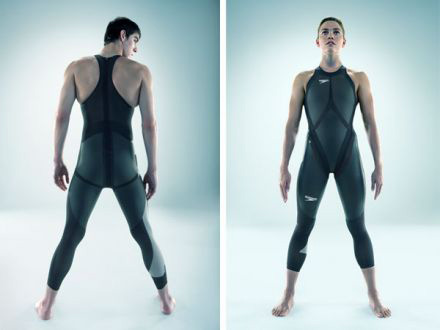
Swimming Suit Technology - What are the Advantages of Hi-Tech Fabrics?
Monday, July 25, 2016
When the Speedo LZR Racer hi-tech swimming suit hit the international swimming community during the 2008 Olympics, the world was mesmerised. The inclusion of non-fabric polyurethane panels to reduce drag and give a smoother passage through the water was so unexpected that it caused a lot of controversy.

Banned
In combination, the new swimsuit features produced a highly streamlined body shape. The three main innovations were tight compression of the abdomen, more skin cover and non-woven fabric that didn't absorb water. And the competitors wearing technological swimsuits gained low friction and faster times in international swimming competitions.
But after a lot of heated argument about cheating, many materials and styles were banned in 2010 by the international swimming federation.
Water-repellent
Since then swimming suit technology has been forced to change direction. But even so, the market has expanded to include a wide selection of new swimwear fabrics, like Fast skin II and Aquablade, which conform to FINA's ban on non-woven polyurethane materials.
The newest fabrics are usually based on a Lycra and nylon mix, with welded seams and water-repellent properties, but body compression suits that act as a corset to pull in a soft abdomen are out!
This is because they're considered to be swimming gear that is a tool that aids swimming, like flippers. And it's hard to argue with that because it removed the need to work hard on developing strong abs and a naturally streamlined outline in the water.
Significant advantage
The question of whether or not the FINA approved high-tech fabrics give a speed advantage is still a subject of great debate. Some manufacturers claim their swim suit technology gives an increase in speed of 3% - 7% and others say their hi-tech fabric reduces drag by as much as 4%.
These may not seem to be big advantages, but when you consider that competitive swimmers are constantly battling to shave off as little as a tenth of a second to break a record, every possible advantage is significant.
Best choice
So what is best for competitive swimmers and triathlon participants? The main question is whether an expensive high-tech swimsuit is going to pay dividends in increased times. The answer is a definite yes, especially now that the prices have tumbled down to a more affordable cost.
For serious swimmers and triathlon competitors, there's almost certainly some speed advantage linked with the low friction, close-fitting high-tech swimsuits.
And for folks who swim for fun, a swimsuit price including years of research into aerodynamics isn't necessary. You won't get any benefits from a suit with microscopically small, shark-fin shapes incorporated into the fabric! And neither will your teenage kids – so no matter how much they insist that they totally need the latest shark-fin swimming suit technology – stand firm!
